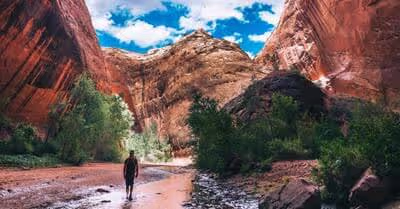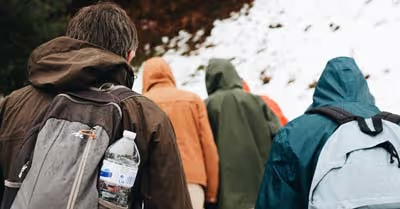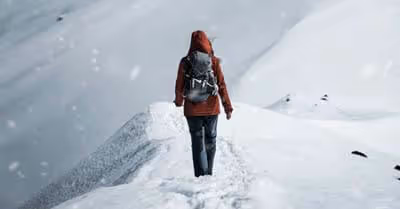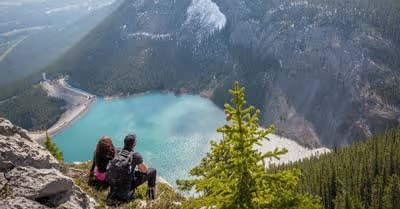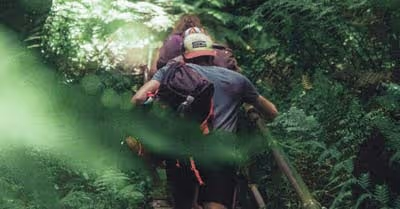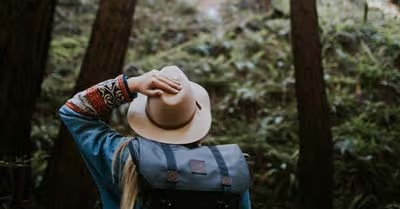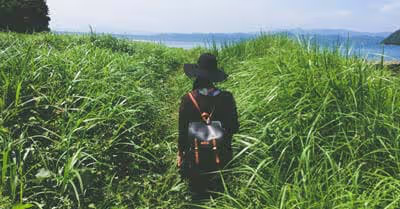Table of Contents
The most dangerous animals you need to be aware of are:
Although all animals must be respected, some animals are more dangerous than others. There is no avoiding it. It is not just the predators that you must be extra cautious of. Any large animal has the potential to cause you tremendous damage if you aren’t always vigilant. The most dangerous animals that you must watch out for are as follows.
Bears:
Bears are probably the most dangerous animal you will encounter on the trail. Bears are likely to avoid you unless they are hungry. But that doesn’t mean you won’t see one. It cannot be stressed enough how much you do not want to see a bear. It is best for you, and it is best for the bear, that you never meet. The best way to avoid meeting is to call out along the trail. It may sound counter-intuitive at first to call out, “wouldn’t that tell the bear where I am?”, but bears don’t want to find you. Bears will avoid you as much as possible, by calling out “Hey bear!”, or anything else you choose, periodically on the trail the bear will know where you are and how to avoid you. The worst thing you can do is accidentally sneak up on a bear. The bear will turn aggressive very quickly and attack you out of fear.
If a bear attacks you, you are in real trouble. Whether it is a black bear or a grizzly bear, you cannot compete. They are so much faster and stronger than you are. The difference between them though is that a grizzly bear probably won’t attack you unless it is starving or scared. On the other hand, black bears will attack you for sport and play with you. They won’t even attack you to eat you, just for their amusement. How to protect yourself against a bear attack is explained later in the article.
Bear cubs:
Just like bears, their cubs are dangerous. You could probably outrun a cub and wouldn’t be overly troubled fighting off a very young one. Chances are the cub wouldn’t attack you either, it wouldn’t see you as a problem most likely. The real danger is the mother. If the mother bear spots you near her cubs she will rush you and viciously attack you until either you’re dead or she is. Never put yourself in a situation where you are between a mother bear and her cubs. If you do happen to stumble upon some bear cubs, turn around and get away as quickly as you can. Chances are the mother is nearby and you do not want to be there when she returns. Many people see the cute cubs and think they have lost their mother and need your help. They don’t. Even if they do lose their mother, they can fend for themselves. Baby bears are much more capable than baby people, they can fend for themself.
Mountain lions:
It is very unlikely for you to see a mountain lion. They are very shy and tend to avoid people. There have only been around 20 mountain lion related deaths in the United States over the last 100 years. This does not mean you don’t need to be wary of them though. Mountain lions are incredibly powerful, and incredibly quick. If you suspect a mountain lion is stalking you, it is best you calmly start walking back down the trail the way you came. Never run, or you may cause the mountain lion to give chase. There is a saying, that if you see a mountain lion he has already been watching you for the last few hours. This is a good indication it is time for you to leave. It is better to get away now, don’t just risk it because the odds of an attack are low. If you do come face to face with a mountain lion, and it doesn’t run off, stand your ground until it does flee. If you turn to run it might sense opportunity and attack.
Moose:
A moose may not seem to fit in with these huge predators, but it does. Moose attack more people each year in Alaska than bears do. It still isn’t a huge number, but it is enough that we must take notice. A moose will likely run away if it sees you, but there is a small chance it will charge. Moose are huge, much larger than even the biggest of horses. Because of this, if a moose tries to run you down you won’t stand a chance. They are also very powerful kickers and can kill a grown man with just one huge kick to the chest. If you just give them plenty of space, you will be fine. Like bears, if a moose is with its babies, stay away. They too are very protective mothers.
Is it okay to stop and take pictures?
Whilst it is sometimes fine for you to take pictures of these animals, it is better not to. You want to be as far away from them as possible in most situations. If you do find yourself watching them from a safe distance, a few hundred feet at least, it might be okay to take a picture. You must use your common sense in these situations to help you decide what is safe and what isn’t. Never go for the close-up.
Is it okay to feed them?
No. It not okay to feed these animals; bears especially. You don’t want these animals to associate people with food; again, especially bears. If these animals come to rely on people for their food they begin to become braver and will approach people more freely. This is dangerous for them, and the people they approach. You cant feed these animals out of your hand under any circumstance.
The more common and less dangerous are:
Not all animals you might encounter on the trail are as life-threatening as those mentioned above. Some are much smaller, and much less likely to attack you. But they still deserve your respect and warrant caution. Some other animals you might encounter but are far less dangerous are as follows:
Skunks:
I am certain you know a little about skunks, probably from cartoons, so understand that they can spray a horrible smelling liquid. Skunks will only spray you if you get too close to them, luckily. Because it is VERY hard to get the smell of skunks off you. It is overbearing and vile, potentially staying on you for days. Not only do skunks spray, but they also have a high chance of having rabies. Rabies can be transferred to people meaning even if you are vaccinated you can still get it from coming in contact with a skunk. Skunks also scratch, if you get too close.
Squirrels:
Squirrels are probably the ones you will see the most. They are completely harmless, even if squirrels do come up to you they most likely will just watch to see what you do. Although they too may have rabies and can scratch or bite, this is not going to happen. They won’t come close enough to you for that to be a problem, and if they do you won’t touch them. They are still wild animals, even though you might see them in the garden too, and should be left alone.
Raccoons:
Raccoons are frequently seen on the trail and like squirrels, will probably avoid you. Unless you happen to have open food on you. Raccoons are greedy little critters and will come right up to you to steal your food. Just because they come up to you, doesn’t mean they are permitting you to pet them. Raccoons can turn vicious and claw at you if they feel threatened if they come up to you, just leave them be.
Deer:
You might be lucky enough to see deer on your hike. If you do, you have nothing to worry about. They will instinctively bolt whenever they see, smell, or hear you. If you happen to find a dead deer, however, that could be an indication of bears or mountain lions. If that is the case, you should turn around and head back down the trail immediately. You don’t want to be around if there are predators nearby.
Is it okay to stop and take pictures?
Yes, unlike the predators it is completely fine to take pictures of these smaller animals. They may be hard to photograph, being small and fast, but if you are lucky enough to get a good photo opportunity, feel free to take it. Don’t try to approach the animals to take better, close up, photos. You could spook them which is firstly mean, but could also lead to them becoming hostile towards you.
Is it okay to feed them?
You shouldn’t feed wild animals, as a rule of thumb, but if one of these little guys comes up to you and you feel like throwing thems some small amounts of fruit that is probably okay. Don’t throw anything likely to attract a predator, like meat or fish, or you may invite trouble. Also, don’t give them processed foods, their bodies aren’t designed to deal with that. Additionally, don’t try to feed them directly out of your hands. They may attack you to get the food. You could also pick up their various diseases, such as rabies or tetanus.
What items can you bring with you to keep yourself safe:
There are some various items you can bring with you for protection, most are pretty cheap and can be picked up at hunting stores. Don’t be one of those people that skips out on these items to save time and money, it is better to be safe than sorry. Especially when it is your life that is on the line. The five best things you can bring are as follows:
Airhorn:
An outdoor airhorn can be a great item to keep on hand. The loud noise can be used to scare away predators, such as bears or mountain lions. Though it can potentially startle them and cause them to attack. These horns are best used as a bonus safety precaution, not as your only item of protection. On the plus side, these horns can be used to attract the attention of rescuers should you come into trouble. They can be very loud, so cover your ears with a hat or your hands if you can.
Bear spray:
Bear spray is like pocket mace spray on steroids. It is incredibly powerful and should only be used outdoors in an emergency. Face the spray towards the bear, cover your eyes as best you can, and spray directly at the bear. It will almost completely blind the bear and allow you to run away. Get as far away from the bear as possible, and keep running for as long as you can. The bear most likely won’t chase you. Bear spray can be used on any animal that is a direct threat to you. If you get bear spray in your eyes, you will be even more affected than the bear. For that reason, you really must be very careful. Sometimes it is possible to buy goggles, or a mask, to wear when you use the spray to stop you from being affected.
Knife:
A knife should be a part of your hiking pack, not just for the use in the case of animals. The way a knife should be used to protect yourself is if an animal is pretty much on top of you and it is not safe to fire a gun, and running away isn’t an option. A knife may be enough to convince whatever animal that is attacking you to leave you alone. When using a knife in self-defense, there is a chance you may end up cutting yourself just as much as what is attacking you. For this reason, you must use a knife only when you need to.
Handgun:
A handgun makes much more sense for your self-defense than a knife does. If you are being rushed by a bear, mountain lion, or any other large predator the noise of the gun firing might spook them enough to leave. Firing a gun is incredibly dangerous, so you must seek proper training if you plan to carry one on you. Shooting a wild animal should truly only be used as a last resort, you entered their domain and that fact must be respected. Shooting and killing these animals is a crime in some places unless it was in self-defense. You should report whatever animal you shot to a park ranger as soon as you make it back to safety. Or you may find yourself in a spot of trouble with the law.
A dog:
Bringing your dog on your hike can be a great way to keep yourself safe, bond with your best friend, and give your dog the exercise it needs. Having a dog with you has plenty of huge safety benefits. They are as follows:
Early warning:
Your dog’s smell and hearing are far greater than yours is. This means your dog is likely to warn you of a predator much before you would otherwise notice. A dog’s nose can be used as an early warning alarm system to any potential threats. If you don’t keep your dog on a leash, be careful he won’t run off to investigate the predator. He won’t win against a mountain lion. Your dog’s life is just as precious, so keep him on a leash for his safety.
Protection:
If you do have a predator try to attack you, your dog will fight tooth and claw to protect you. This can make the difference in a fight for your life between winning and losing. Even the smallest dogs can be deadly when they need to be. Your dog is not meant to be used as a sacrifice. If you bring a dog for your safety, they are your responsibility to bring them home safely.
Scare predators:
If you happen to come face to face with a predator on the trail, it is best not to run. Stand your ground and they will probably leave. If you do run, they may sense the opportunity and charge you. By having a dog with you, barking and yapping at the predator, while you stand your ground you will likely scare the predator off. Bears especially will only attack if they think they will get something out of it, if you make yourself seem as much of a problem as possible, they will leave you alone. Furthermore, the time your dog is barking will give the predator cause to pause and assess if you are worth the trouble. During this time you can get your bear spray, gun, airhorn, or knife out.
How to avoid dangerous situations:
The best way to avoid these dangerous situations is to use your common sense mostly. Stick to the trails, call out “hey bear!”, and try to be aware of your surroundings as much as possible. If you get that tingly feeling, your hairs start standing up on the back of your neck, you should leave immediately. That is your body warning you of potential danger, and you should listen to it.
What to do if an animal attacks:
If an animal does attack, use every tool at your disposal to save yourself. There is no time to worry about what is excessive and what is not when your life is on the line. If you can run away from a smaller animal, like a skunk or raccoon, do so. If running is out of the question, your best bet is to use your bear spray and then shoot at the blinded animal. If you manage to injure it, don’t stick around. Get as far away as fast as possible.
If you don’t have anything to defend yourself with, tighten your pack onto your back, lay face down and cover the back of your neck with your arms. You are going to do your best to play dead. When the bear comes to investigate it will try to turn you over onto your back. Do everything you can to stop it. keep your legs wide open, your arms tight over the back of your neck, and don’t move. Hopefully, the bear will leave the area, at which point you will have to get up, run back down the trail toward safety, and don’t look back.
How to prevent them from attacking:
The best way to keep these predators from attacking is to always stand your ground. I know it has been mentioned before, but it is the only action you can take that will be successful nine times out of ten. Even if you are stood watching each other for an hour, don’t turn your back and run. Always let them be the first ones to make a move.
As mentioned above, bringing your dog with you can help deter predators. But it is even better to hike with a buddy. Not just for extra protection from animals but because you never know what will happen on the trail, having someone you rely on can save your life.
Conclusion:
The odds of you bumping into a predator when hiking is minuscule. The chances are you will never use most of this information at any point in your lifetime. But if you do, you now have the information you need to stay safe. Hiking is one of the most enjoyable pastimes, so long as nature is respected you will be just fine. Good luck on the trail, stay safe.
Recent Articles



